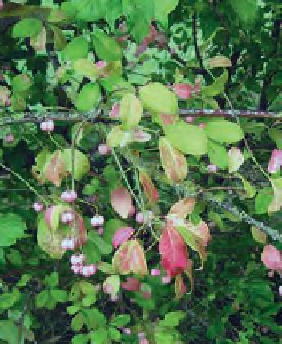Agriculture Reference
In-Depth Information
(b)
(a)
Figure 18.13
(a) Black bean aphid; (b) spindle tree (
Euonymus europaeus
), winter host of black bean aphid
lacewings, hoverflies (see Figures 16.7 and 16.8),
and parasitic fungi (see also p. 198), naturally found in
the environment, may reduce pest numbers. For the
greenhouse, small parasitic wasps such as
Aphidius
matricariae
and
Aphelinus abdominalis
are available
for purchase by gardeners.
Abamectin
,
fatty acids
and
pyrethrins
are three insecticide active ingredients
options for spraying.
aphids develop and, along with the winged females,
fly to the
Euonymus
or spindle tree host where the
overwintering eggs are laid.
Spread
. Is achieved in spring by winged female
aphids.
Control
. This aphid is attacked by several predators
and parasites such as ladybirds, lacewings, hoverflies,
tiny parasitic wasps and parasitic fungi (see biological
control, p. 196), naturally found in the environment.
The gardener can choose between insecticide
products containing different classes of chemical:
pyrethrins
,
natural fatty acids
or
abamectin
.
Black bean aphid (
Aphis fabae
)
This 2 mm long black aphid (Figure 18.13) is
commonly referred to as 'blackfly', although it is not a
fly species. Most individuals are black, but some are
dark olive green. The species on bean should
not
be
confused with another common black aphid (
Myzus
cerasi
) which is found on cherry and ornamental
Prunus
cultivars.
Damage
. The most commonly damaged plant species
are broad beans, but runner beans, French beans,
peas and red beet can be affected. The pest sucks
the sugary phloem liquid from the leaves and flowers,
often leading to a
sooty mould
covering the plant.
Plant growth is affected and seed production in beans
can be seriously reduced, with small misshapen pods
being produced.
Life cycle
. This species survives the winter mainly
as the egg stage on the small shrub
Euonymus
europaeus
(Figure 18.13). In March/April, female
nymphs emerge which, at maturity, fly to the summer
host plants such as beans and beet. Female adults
may lay as many as five young per day, which
themselves are ready to produce more young within
14 days. In warm winters, the pest may survive on
field beans. Several weed species such as docks,
poppies and fat hen can act as
alternate hosts
(see
p. 198) in the summer period. In autumn, male winged
Other aphids
There are many other horticulturally important aphid
species. The
cabbage aphid
(
Brevicoryne brassicae
)
affects cabbages and other brasssicas. The
apple
woolly aphid
(
Eriosoma lanigerum
) causes galls
on apple stems (see Figure 18.14). The
rose aphid
(
Macrosiphum rosae
) attacks young shoots of rose
(see Figure 18.14).
18
Glasshouse whitefly (
Trialeurodes
vaporariorum
)
This small insect (Figure 18.15a), looking like a tiny
white moth (with wings held horizontally when at rest),
was originally introduced from the tropics but now
causes serious problems on a range of glasshouse
food and flower crops. It should not be confused with
the very similar, but slightly larger,
cabbage whitefly
on brassicas (Figure 18.15b). (Another greenhouse
pest,
tobacco whitefly
, is mentioned briefly after the
glasshouse whitefly section.)
Damage
. All stages after the egg have sucking stylets,
which extract a sugary liquid from the phloem, often
causing large amounts of honeydew and sooty moulds



